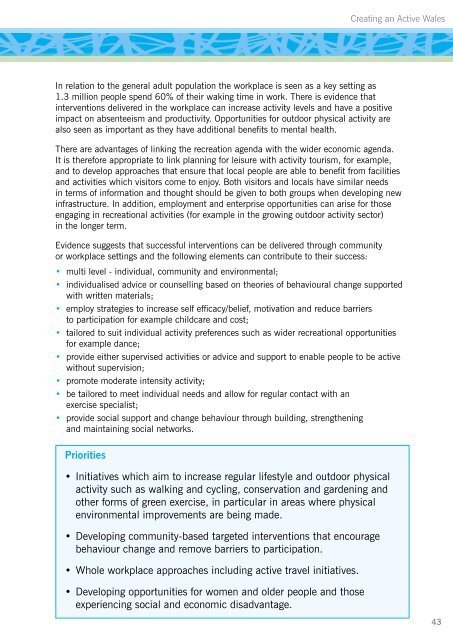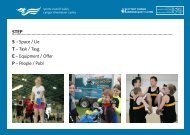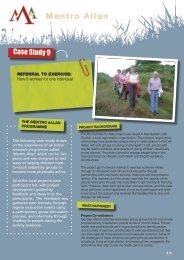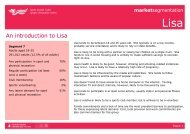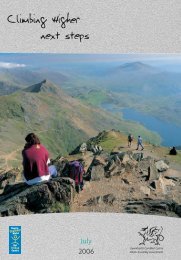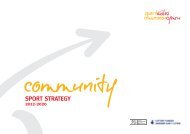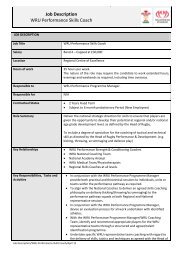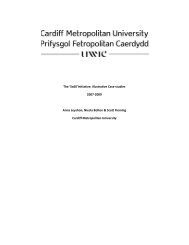Creating an Active Wales - Sport Wales
Creating an Active Wales - Sport Wales
Creating an Active Wales - Sport Wales
- No tags were found...
You also want an ePaper? Increase the reach of your titles
YUMPU automatically turns print PDFs into web optimized ePapers that Google loves.
<strong>Creating</strong> <strong>an</strong> <strong>Active</strong> <strong>Wales</strong>In relation to the general adult population the workplace is seen as a key setting as1.3 million people spend 60% of their waking time in work. There is evidence thatinterventions delivered in the workplace c<strong>an</strong> increase activity levels <strong>an</strong>d have a positiveimpact on absenteeism <strong>an</strong>d productivity. Opportunities for outdoor physical activity arealso seen as import<strong>an</strong>t as they have additional benefits to mental health.There are adv<strong>an</strong>tages of linking the recreation agenda with the wider economic agenda.It is therefore appropriate to link pl<strong>an</strong>ning for leisure with activity tourism, for example,<strong>an</strong>d to develop approaches that ensure that local people are able to benefit from facilities<strong>an</strong>d activities which visitors come to enjoy. Both visitors <strong>an</strong>d locals have similar needsin terms of information <strong>an</strong>d thought should be given to both groups when developing newinfrastructure. In addition, employment <strong>an</strong>d enterprise opportunities c<strong>an</strong> arise for thoseengaging in recreational activities (for example in the growing outdoor activity sector)in the longer term.Evidence suggests that successful interventions c<strong>an</strong> be delivered through communityor workplace settings <strong>an</strong>d the following elements c<strong>an</strong> contribute to their success:• multi level - individual, community <strong>an</strong>d environmental;• individualised advice or counselling based on theories of behavioural ch<strong>an</strong>ge supportedwith written materials;• employ strategies to increase self efficacy/belief, motivation <strong>an</strong>d reduce barriersto participation for example childcare <strong>an</strong>d cost;• tailored to suit individual activity preferences such as wider recreational opportunitiesfor example d<strong>an</strong>ce;• provide either supervised activities or advice <strong>an</strong>d support to enable people to be activewithout supervision;• promote moderate intensity activity;• be tailored to meet individual needs <strong>an</strong>d allow for regular contact with <strong>an</strong>exercise specialist;• provide social support <strong>an</strong>d ch<strong>an</strong>ge behaviour through building, strengthening<strong>an</strong>d maintaining social networks.Priorities• Initiatives which aim to increase regular lifestyle <strong>an</strong>d outdoor physicalactivity such as walking <strong>an</strong>d cycling, conservation <strong>an</strong>d gardening <strong>an</strong>dother forms of green exercise, in particular in areas where physicalenvironmental improvements are being made.• Developing community-based targeted interventions that encouragebehaviour ch<strong>an</strong>ge <strong>an</strong>d remove barriers to participation.• Whole workplace approaches including active travel initiatives.• Developing opportunities for women <strong>an</strong>d older people <strong>an</strong>d thoseexperiencing social <strong>an</strong>d economic disadv<strong>an</strong>tage.43


